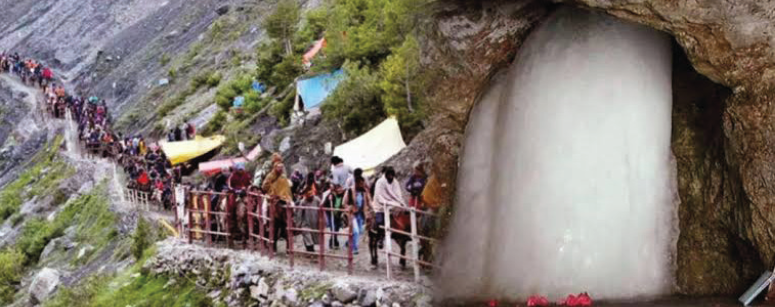Srinagar, Aug 01:In a landmark achievement for sustainable pilgrimage management, the Directorate of Rural Sanitation, Jammu and Kashmir, has successfully collected and processed nearly 300 metric tonnes of waste during the ongoingShriAmarnathJiYatra. The unprecedented scale of waste management, coupled with cutting-edge technology and a dedicated workforce, marks a new milestone in ensuring cleanliness and environmental responsibility along the sacred pilgrimage routes.
According to official data, a total of 290,580 kilograms of waste ,including mule dung, plastic bottles, wrappers, and snack packaging, was collected from the two main routes: Baltal Axis (190,110 kg) and Pahalgam Axis (100,470 kg). Over four lakh pilgrims have performed darshan at the holy cave shrine of Amarnath till July 31.
Officials credited the success to the deployment of advanced waste management machinery such as balers, shredders, and solid-liquid suppression units, alongside a digital sanitation ecosystem featuring QR-enabled toilets and mobile-based grievance systems.
A workforce of over 7,000 sanitation workers has been maintaining round-the-clock cleanliness. “The cleanliness of the Yatra track has been made possible by over 7,300 sanitation workers mobilised in district-level teams from Anantnag, Ganderbal, and others, as well as teams operating prefab toilets, baths, and waste processing units along both axes,” officials said.
An additional 3,584 workers deployed by the Directorate of Rural Sanitation for operating and maintaining prefab toilets, baths, and solid-liquid waste operations along both the Baltal and Pahalgam axes.
Director General of Rural Sanitation, AnooMalhotra, said mechanised solutions have improved operational efficiency and allowed faster response to waste accumulation in remote areas. “This year, we are not just managing waste, we are transforming it. Every scan, refill, and feedback makes the Yatra more responsible and cleaner,” she added.
To ensure hygiene and comfort, over 4,000 toilets and nearly 900 baths were installed. The Baltal Axis features 1,830 toilets and 560 baths, while the Pahalgam Axis has 2,215 toilets and 285 baths. An additional 723 pucca-base toilets were set up by SASB. All units are geo-tagged and monitored through a real-time dashboard integrated with the official Yatra portal and app.
The officials said that in a bid to modernise sanitation infrastructure, the Directorate introduced QR code-enabled public toilets across both pilgrimage routes. Pilgrims can scan codes at each toilet block to–lodge a complaint or maintenance request, track last cleaning time, submit feedback and access emergency sanitation help. “The system feeds data into a central monitoring dashboard, allowing officials to act quickly and maintain service quality,” Officials said.
As part of its Zero-Landfill Yatra initiative, the Directorate established 15 Waste Processing Centres, including a major cluster at Nunwan, four Plastic Waste Collection Centres and six RO-based Water ATMs (3 each at Baltal and Chandanwari). “The Water ATMs, which provide free RO drinking water, are aimed at discouraging the use of single-use plastic bottles — a major pollutant in previous Yatras,” the Officials said. “The deployment of baling machines and waste shredders has significantly reduced the bulk of collected waste. Shredders with a capacity of 400 kg/hour have reportedly brought down waste volume by 60 per cent enabling easier recycling and transportation.
Eco Yatra:
300 tonnes of waste processed
Waste from Baltal&Pahalgam routes
4 lakh+ pilgrims visited
Advanced waste machines used
7,000+ sanitation workers deployed
4,000+ toilets, 900 baths installed
QR code toilets for complaints
15 Waste Processing Centres active
Six RO Water ATMs installed
Waste volume reduced by 60%
Tech improves waste management










